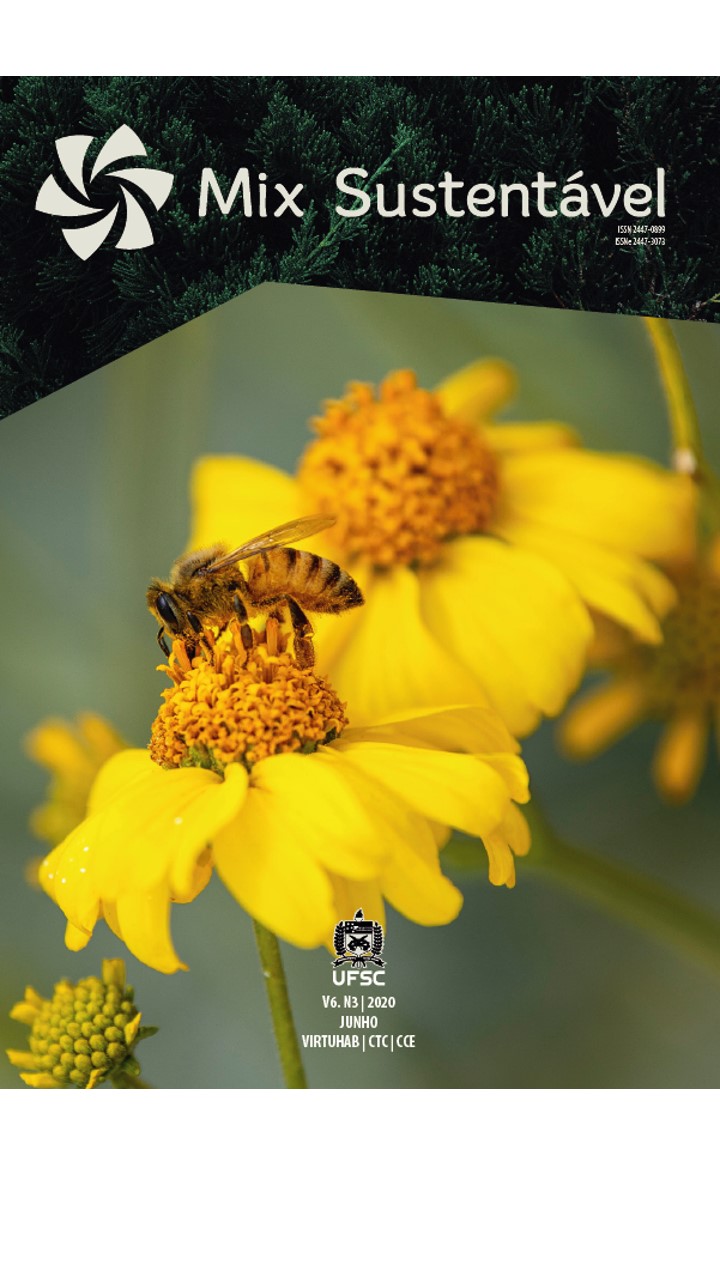SIMULAÇÃO E AVALIAÇÃO EXPERIMENTAL DE ESTRUTURAS GEODÉSICAS DE BAMBU REFORÇADAS COM CABOS
DOI:
https://doi.org/10.29183/2447-3073.MIX2020.v6.n3.71-82Palabras clave:
Estruturas geodésicas, Barras de bambu, Ensaios mecânicos, Reforço com cabos, Métodos de Elementos Finitos (MEF)Resumen
O objetivo deste trabalho é analisar o comportamento do reforço feito com cabos de nylon trançado feito em estruturas geodésicas construída com barras de bambu cilíndricas e maciças unidas com resina de poliéster com carga mineral. As cúpulas geodésicas estudadas têm a forma de meio icosaedro truncado e foram construídas com barras comerciais de bambu Phyllostachys pubescens com 4mm de diâmetro e comprimento de 175mm. O software de simulação de engenharia ANSYS foi usado para desenhar e simular a estrutura da cúpula sob carga, com e sem o reforço de cabos. O modelo geodésico construído e testado através de carregamento vertical, mostrou resultados de deflexão no regime elástico muito semelhantes ao comportamento previsto pelo modelo computacional. Enquanto a estrutura sem reforço apresentou grandes deformações e resistiu 14,8 vezes o seu próprio peso com comportamento linear e 23 vezes o seu próprio peso sem ruptura; a estrutura reforçada com cabos amarrados resistiu comparativamente o dobro de carga vertical final com apenas 40% da deflexão apresentada pela estrutura sem reforço, mostrando a efetividade do uso dos cabos de nylon como reforço amarrado. Comportamento previsto pela simulação numérica.Referencias
BERNDSEN, R.S., KLITZKE, R.J., BATISTA, D.C., NASCIMENTO, E.M., OSTAPIV, F. “Resistência à flexão estática e à compressão paralela do bambu-mossô (Phyllostachys pubescens)” Floresta, v.43, n°3, p. 485 – 494, jul./set. 2013 – Curitiba PR.
CASTRO, G. C. “Ensaio e simulação computacional de estrutura geodésica tipo icosaedro truncado construída com barras de bambu”. 93 f. Trabalho de Conclusão de Curso (Graduação em Engenharia Mecânica) – Universidade Tecnológica Federal do Paraná. Pato Branco, 2019.
COOK, R.D., MALKUS, D. S. PLESHA. M. E. “Concepts and Applications of Finite Element Analysis” 3ed. Madison: Editora John Wiley and Sons Ltd, 1988.
GHAVAMI, K., MOREIRA, L.E. “Double-layer bamboo space structures”: Space Structures 4, ed: Thomas Telford Ltd, vol.1, p. 573-581. 1993.
GHAVAMI, K., MOREIRA, L.E. “Buckling behavior of compression elements in bamboo space structure”: Space Structures 5, ed: Thomas Telford Ltd, vol.1, p. 133-144, 2002.
HIBBELER, R. C. “Resistência dos materiais”. Pearson-Prentice Hall, 5a ed. 670 p., New York, 2010.
HILL, J.O. “Professional Dome Plans”, 3a ed. 2002.
LANGDON D. Disponível em: <https://www.archdaily.com.br/br/796023/classicos-da-arquitetura-biosfera-de-montreal-buckminster-fuller >. Acesso em 18, Set., 2018.
LENGEN, J.V. “Arquitetura dos índios da Amazônia” B4 Editores, 119p, São Paulo, 2013.
LIBRELLOTO, L.I., OSTAPIV, F. (org) “Bambu caminhos para o desenvolvimento sustentável no Brasil” 1ª ed. Virtuhab, 204p. Florianópolis, 2019.
OSTAPIV, F., SALAMON, C., STAHLSCHMIDT, J., BETT, C. F. “Estudos iniciais para ensaios e construção de cúpulas geodésicas usando colmos de bambu”. MIX Sustentável, v.4, n.1, p. 108-116. UFSC, Florianópolis, 2018.
OSTAPIV, F., OSTAPIV, G., CASTRO, G.C., STAHLSCHMIDT, J., “Computational simulation and vertical loading tests in bamboo geodesic domes”. In: 25th International Congress of Mechanical Engineering - ABCM, Uberlândia, MG, out. 2019.
ROZESTRATEN, A. S. “Apuntes acerca del papel de la representación en el processo del proyecto de arquitectura de Paulo Mendes da Rocha”. Arquiteturarevista - Vol. 5, n°2: p.111-121. São Paulo, 2009.
SALAMON, C., OSTAPIV, F. Planificação de Colmos de Bambu para Produção de Painéis. Mix Sustentável - Edição 05 v.3, n.1. p.73-83. UFSC, Florianópolis, 2017.
SALCIDO, J.C.; RAHEEM, A.A.; RAVI, S. “Comparison of embodied energy and environmental impact of alternative materials used in reticulated dome construction” Building and Environment 96: The International Journal of Building Science and its Applications, Elsevier, p. 22-34. 2016.
Descargas
Publicado
Número
Sección
Licencia
Aviso de Direito Autoral Creative Commons
1. Política para Periódicos de Acesso Livre
Autores que publicam nesta revista concordam com os seguintes termos:
a. Autores mantém os direitos autorais e concedem à revista o direito de primeira publicação, com o trabalho simultaneamente licenciado sob a Licença Creative Commons Attribution que permite o compartilhamento do trabalho com reconhecimento da autoria e publicação inicial nesta revista.
b. Autores têm autorização para assumir contratos adicionais separadamente, para distribuição não-exclusiva da versão do trabalho publicada nesta revista (ex.: publicar em repositório institucional ou como capítulo de livro), com reconhecimento de autoria e publicação inicial nesta revista.
c. Autores têm permissão e são estimulados a publicar e distribuir seu trabalho online (ex.: em repositórios institucionais ou na sua página pessoal) a qualquer ponto após o processo editorial, já que isso pode gerar alterações produtivas, bem como aumentar o impacto e a citação do trabalho publicado (Veja O Efeito do Acesso Livre).




